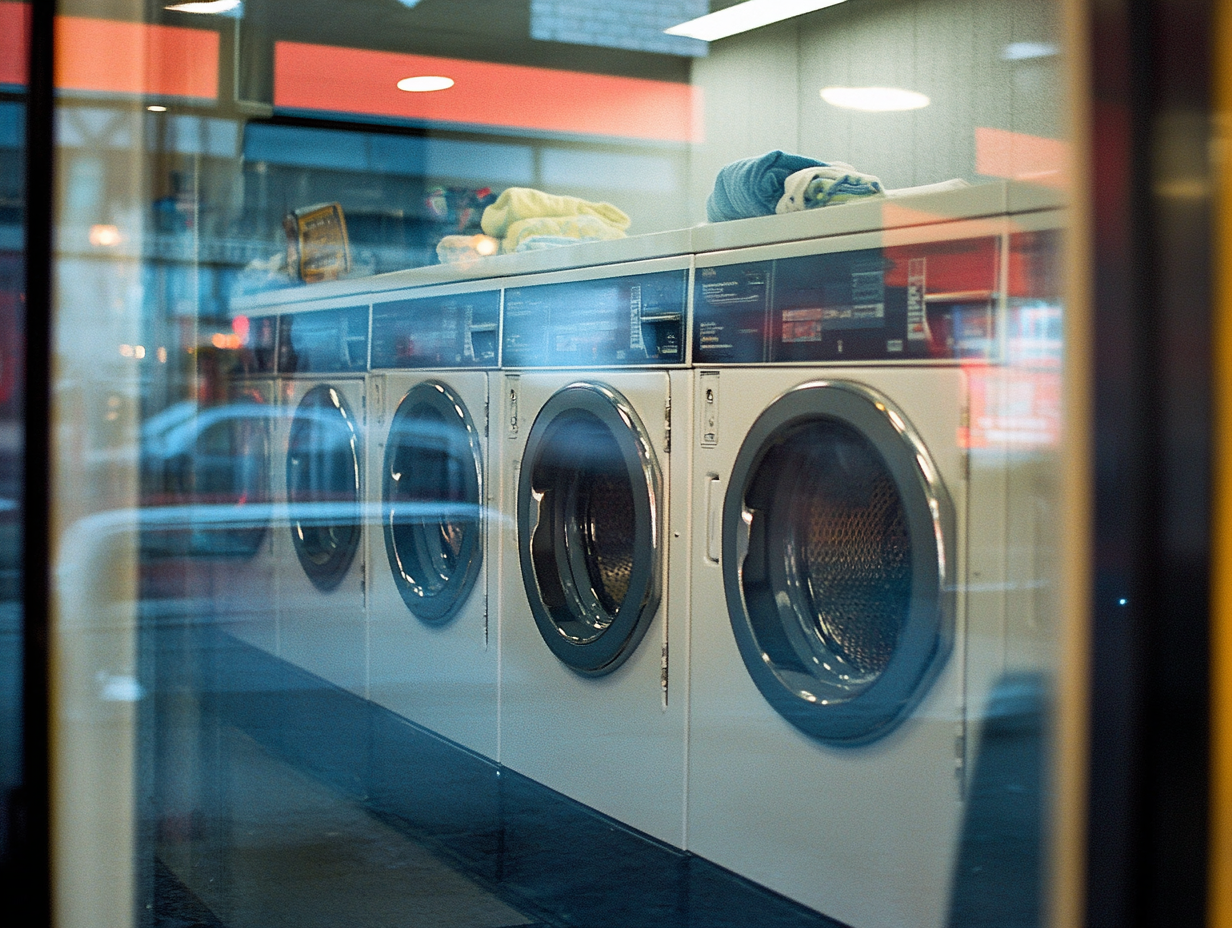Laundromats (also known as coin laundries) are a fixture in many American communities, providing space for people to wash and dry clothes when they don’t have laundry machines at home. These businesses are surprisingly common – there are an estimated 30,000–35,000 laundromats across the United States, together generating around $5–6 billion in annual revenue. Laundromats offer an essential service (clean clothes are a basic need), and they tend to have steady demand year-round.
The Laundromat Business Model
At its core, a laundromat operates as self-service laundry. The owner equips a retail space with commercial washers and dryers, and customers pay per cycle to wash and dry their clothes.
Originally, these were strictly coin-operated machines, but many modern laundromats now accept debit or reloadable laundry cards. Since customers pay upfront, there’s no inventory to stock or receivables to manage—resulting in immediate cash flow and a simple business model.
Laundromats also meet an essential, recurring need. Demand remains steady even in economic downturns, when more people rent homes or forgo personal laundry appliances.
Key advantages include:
-
- Long-term leases (10–25 years) that help secure prime locations and customer loyalty.
-
- Daily income in small increments (cash or card-based).
-
- Net margins of 20–35%, often higher than other small businesses due to low labor and inventory costs.
- Net margins of 20–35%, often higher than other small businesses due to low labor and inventory costs.
Typical Laundromat Setup and Services
A traditional laundromat setup is fairly straightforward. Most stores occupy 1,000–5,000 square feet of retail space, often located in strip malls or on busy city streets. Inside, rows of heavy-duty front-loading washers and large-capacity dryers line the walls or are arranged in islands. Larger stores may house 40–100 machines to serve multiple customers at once.
To support customers, laundromats usually provide:
-
- Folding tables for clean laundry
-
- Rolling carts for easy load transfers
-
- Seating areas or benches for waiting
-
- Change machines or card kiosks for payments
-
- Vending machines with detergent, fabric softener, dryer sheets, snacks, or drinks
-
- Restrooms, TVs, Wi-Fi, or magazines in some locations
Services Offered
The core service is self-service laundry, where customers bring detergent, load machines, and pay per cycle. Pricing typically ranges from a few dollars per wash to pay-per-use drying (e.g., minutes per quarter).
Many laundromats also provide additional services:
-
- Wash-and-fold (drop-off): staff wash, dry, and fold clothes, usually priced per pound.
-
- Dry-cleaning drop-off: some partner with external dry cleaners for garment care.
Not all laundromats offer attended services. Smaller stores often run unattended, relying on self-service only. In attended stores, staff handle wash-and-fold orders, assist customers, and ensure cleanliness. Across all models, owners focus on safety and upkeep with clean facilities, good lighting, and sometimes security cameras—especially for late-night or 24/7 operations.
Operating Hours
Laundromats typically stay open long hours—6 a.m. to 10 or 11 p.m. daily—to accommodate customer schedules. Some operate 24/7, which appeals to shift workers and night users. Peak usage usually occurs on weekends when customers catch up on household laundry.
Overall, the layout and service mix are designed for convenience and ease of use, letting customers come in, do laundry with minimal hassle, and return regularly.
Laundromat Ownership & Business Structure
In the U.S., laundromats are mostly independently owned businesses run by individuals or families. Unlike other industries, there are no large national chains, only a few small regional franchises.
Most laundromats operate with very few employees. An unattended store may run with no staff at all, while attended locations usually have just one or two people on-site to manage wash-and-fold services, cleaning, and customer assistance.
Because staffing needs are low, many owners choose to operate multiple locations. Businesses are typically set up as sole proprietorships or small LLCs, making laundromats a straightforward investment.
The industry also shows strong stability. Studies report that about 95% of laundromats survive their first five years, thanks to consistent demand and simple operations. While startup costs can be high due to equipment and leasehold improvements, many laundromats become long-term, profitable businesses that are passed down or sold to new owners.
Revenue Streams in a Laundromat
Vended Supplies and Amenities: Nearly all laundromats have vending machines or dispensers selling laundry supplies like single-load boxes of detergent, bleach, and softener. They may also house snack or drink vending machines. While these sales are smaller, they provide convenient extras for customers and extra dollars for the owner. Some laundromats also have coin-operated arcade games or kiddie rides, or an on-site ATM that earns a transaction fee – every little ancillary service can contribute to revenue.
Wash-and-Fold Service: If the laundromat is attended, offering a wash–dry–fold laundry service can be a lucrative add-on. Customers drop off bags of dirty laundry and the staff launders it for a fee (often charging around $1–$2 per pound of laundry). Because of the added labor, wash-and-fold service commands a higher price and margin than self-service. Even a few regular drop-off clients (such as local businesses or busy families) can generate a steady weekly income for the store. Many laundromat owners report that wash-and-fold orders provide a nice supplement to the coin machine revenue, and they can schedule this work during slower hours of the day.
Dry Cleaning Drop-Off: Some laundromats partner with dry cleaning operators. The laundromat will accept clothing that needs dry cleaning from customers, then send those items out to a wholesale dry cleaner and get them back in a day or two for customer pickup. The laundromat earns a commission or markup on each item. This service is convenient for customers and brings in additional business, though it’s a smaller portion of revenue compared to washing and drying.
Other Miscellaneous Services: A few laundromats might offer niche services like garment pressing/ironing or tailoring, but these are less common in a traditional coin-op setting. The bread and butter of the business remains the self-service laundry fees, with the other services providing incremental income. Notably, the combined revenue from these sources can make a well-run laundromat quite profitable – after covering expenses, owners often see healthy cash flow. (It’s typical for a laundromat to produce cash flow in the tens of thousands of dollars per year for the owner.)
Key Cost Drivers and Expenses
Running a laundromat comes with several fixed and variable costs that affect profitability. While there’s no inventory to stock, expenses like rent, utilities, and equipment upkeep are significant.
-
- Rent & Lease Costs
Usually the largest fixed expense. Laundromats need commercial spaces with utility hookups, often on long-term leases. In addition to base rent, owners may face CAM fees, taxes, and insurance. High rent can quickly erode margins.
- Rent & Lease Costs
-
- Utilities (Water, Electricity, Gas)
The biggest ongoing cost. Washers and dryers consume large amounts of water, electricity, and gas. Efficient machines and water heaters help, but utilities typically remain a major share of expenses.
- Utilities (Water, Electricity, Gas)
-
- Equipment Maintenance & Repairs
Commercial machines take heavy wear. Owners must budget for regular maintenance, repairs, and eventual replacements. Out-of-order machines mean lost revenue, so upkeep directly impacts earnings.
- Equipment Maintenance & Repairs
-
- Labor (Staff Payroll)
Unattended stores have minimal payroll, but attended laundromats (especially those offering wash-and-fold) require staff. Even unattended locations often pay for cleaning and maintenance.
- Labor (Staff Payroll)
-
- Insurance & Licenses
Owners need liability and property coverage, plus any required permits. Costs are modest compared to rent or utilities but remain essential.
- Insurance & Licenses
-
- Supplies & Miscellaneous
Includes cleaning supplies, packaging for wash-and-fold, wholesale products for vending, marketing, accounting, and card processing fees.
- Supplies & Miscellaneous
Customer Demographics and Usage Patterns
Successful owners control expenses by negotiating leases, monitoring utility use, and maintaining equipment efficiently. Since there’s no product inventory, once fixed costs are covered, most additional revenue turns into profit. Industry benchmarks show well-run laundromats net 20%–30% margins, though high rent or utility rates can lower this.
Laundromats primarily serve people without in-home laundry facilities or those needing large-capacity machines. Renters are the core customer base, as many apartments lack private laundry. Usage is common among low- to moderate-income individuals, college students, and working-class families. Industry surveys report a median household income of about $28,000 for laundromat patrons, underscoring their budget-conscious nature. Homeowners also visit occasionally to wash oversized items, like comforters, that don’t fit in standard machines.
More than 60% of laundromat users are women, reflecting household laundry responsibilities and single-parent households. Customers are highly local—87% live within a mile of the laundromat they frequent. Convenience drives loyalty, with about 90% of users returning regularly, often building weekly routines like Saturday morning laundry trips. This repeat usage highlights the importance of reliable service and well-maintained facilities.
Laundromats thrive in urban and densely populated neighborhoods, where apartments and small living spaces are common. Suburban and rural areas host fewer locations, but demand still exists in communities with older housing or high renter concentrations. Overall, laundromat customers value affordability, convenience, and accessibility. Demographic trends, particularly the growth of renter populations, continue to sustain demand and keep laundromats central to neighborhood life.
Day-to-Day Operations and Considerations
Running a laundromat on a daily basis involves a mix of hands-off automation (the machines do the work and customers serve themselves) and hands-on management behind the scenes. Operationally, there are a few areas of focus for a laundromat owner or manager.
Cleanliness: Facilities must be kept sanitary and inviting. Tasks include wiping machines, cleaning lint traps, mopping floors, servicing restrooms, and emptying trash. Attended stores handle this throughout the day, while unattended locations usually get cleaned once daily. A clean, well-kept space is essential for customer trust.
Machine Maintenance: Equipment must stay in working order. Minor repairs can be handled on-site, while technicians are called for major issues. Preventive maintenance—checking hoses, lubricating parts, and replacing worn components—reduces downtime. Keeping spare parts and logging repairs helps ensure machines stay functional, especially during peak weekends.
Money and Accounting: Coin machines need regular collection and counting, while card-based systems require digital reconciliation. Owners track revenue per machine, total income, and expenses. Since laundromats often deal in cash, accurate bookkeeping and secure deposits are critical.
Customer Service: Even in self-service models, support is needed for refunds, machine issues, or usage questions. Attendants assist customers directly; unattended stores typically post a phone number for emergencies. For wash-and-fold services, daily tasks include sorting, washing, folding, and delivering orders on time. Reliability and friendliness drive repeat business.
Security and Safety: Operators monitor surveillance cameras, lighting, and overall safety conditions. In busy cities, police may include laundromats in patrols. The goal is to create a safe, comfortable environment for all customers, even during late-night hours.
Summary
The U.S. laundromat industry operates on a simple model: customers pay to use washers and dryers for convenient, affordable laundry service. For owners, it offers steady income when costs like rent, utilities, and maintenance are managed well. For customers, laundromats are an essential neighborhood amenity, especially in urban and rental-heavy areas. By combining necessity with convenience, laundromats remain a reliable part of everyday life and the local economy.








